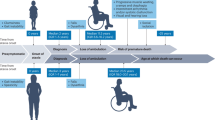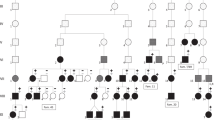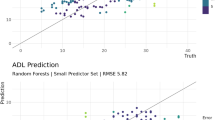Abstract
Haplotype analysis is a powerful approach to understand the spectrum of mutations accounting for a disease in a homogeneous population. We show that haplotype variation for 10 markers linked to the Friedreich ataxia locus (FRDA) argues in favor of an important mutation homogeneity in the Spanish population, and positions the FRDA locus in the region where it has been recently isolated. We also report the finding of a new single nucleotide polymorphism called FAD1. The new marker shows a very strong linkage disequilibrium with Friedreich ataxia (FA) in both the Spanish and French populations, suggesting the existence of an ancient and widespread FRDA mutation. Inclusion of FAD1 in the extended haplotype analysis has allowed to postulate that this main FRDA mutation could account for 50–90% of the disease chromosomes. The results indicate that FA, despite clinical heterogeneity, could have originated from a few initial mutations.
Similar content being viewed by others
Log in or create a free account to read this content
Gain free access to this article, as well as selected content from this journal and more on nature.com
or
References
Harding AE: The hereditary ataxias and related disorders. Edinburgh, Churchill Livingstone, 1984.
Chamberlain S, Shaw J, Rowland S, Wallis J, South S, Nakamura Y. von Gabain A, et al: Mapping of mutation causing Friedreich ataxia to human chromosome 9. Nature 1988;334:248–250
Chamberlain S, Shaw J, Wallis J, Rowland A, Chow L, Farrall M, Keats B, et al: Genetic homogeneity at the Friedreich ataxia locus on chromosome 9q. Am J Hum Genet 1989;44:518–521
Fujita R, Hanauer A, Sirugo G, Heiling R, Mandel JL:. Additional polymorphisms at marker loci D9S5 and D9S15 generate extended haplotypes in linkage disequilibrium with Friedreich ataxia. Proc Natl Acad Sei USA 1990;87:1796–1800.
Pandolfo M, Sirugo G, Antonelli A, Weitnauer L, Ferretti L, Leone M, Dones I, et al: Friedreich ataxia in Italian families: Genetic homogeneity and linkage disequilibrium with the marker loci D9S5 and D9S15. Am J Hum Genet 1990;47:228–235
De Michelle G, Filla A, Cavalcanti F, Di Maio L, Pianese L. Castaldo I, Calabrese O, Monticelli A, et al: Late onset Friedreich’s disease: clinical features and mapping of mutation to the FRDA locus. J Neurol Neurosurg Psychiatry 1994;57:977–979
Palau F, De Michelle G, Vilchez JJ, Pandolfo M, Monrós E, Cocozza S, Smeyers P, LópezArlandis J, et al: Early-onset ataxia with cardiomyopathy and retained tendon reflexes maps to the Friedreich’s ataxia locus on chromosome 9q. Ann Neurol 1995;37:358–362
Wallis J, Williamson R, Chamberlain S: Identification of a hypervariable microsatellite polymorphism within D9S15 tightly linked to the Friedreich ataxia locus. Hum Genet 1990;85:98–100
Sirugo G, Keats B, Fujita R, Duclos F, Purohit K, Koenig M, Mandel JL: Friedreich ataxia in Louisiana Acadians: Demonstration of a founder effect by analysis of microsatellite-generated extended haplotypes. Am J Hum Genet 1992;50:559–566
Duclos F, Boschert U, Sirugo G, Mandel JL, Koenig M: New gene in the region of the Friedreich ataxia locus encodes a putative transmembrane protein expressed in the nervous system. Proc Natl Acad Sei USA 1993;90:109–113
Pandolfo M, Murano M, Cocozza S, Redolfi EM, Pianese L, Cavalcanti F, Monticelli A, et al:. A dinucleotide repeat polymorphism (D9S202) in the Friedreich ataxia region on chromosome 9q 134-21.1. Hum Molec Genet 1993;2:822.
Rodius F, Duclos F. Wrogemann K, Le Palsier D, Ougen P, Billault A, Belal S, et al: Recombinations in individuals homozygous by descent localize the Friedreich ataxia locus in a cloned 450 kb interval. Am J Hum Genet 1994;54:1050–1059
Duclos F, Rodius F, Wrogemann K, Mandel JL, Koenig M: The Friedreich ataxia region: characterization of two novel genes and reduction of the critical region to 300 kb. Hum Mol Genet 1994;3:909–914
Chamberlain S, Farrall M, Shaw J, Wilkes D, Carvajal J, Hillerman R, Doudney K, Harding AE, et al: Genetic recombination events which position the Friedreich ataxia locus proximal to the D9S15/D9S5 linkage group on chromosome 9q. Am J Hum Genet 1993;52:99–109
Belal S, Panayides K, Sirugo G, Ben Hamida C, Ioannou P, Hentati F, Beckmann J, Koenig M, et al: Study of large inbred Friedreich ataxia families reveals a recombination between D9S15 and the disease locus. Am J Hum Genet 1992;51:1372–1376
Pandolfo M, Pizzuti A, Redolfi E, Murano M, Di Donato S, Cavalcanti F, Filla A, Monticelli A, Pianese L, Cocozza S: Isolation of a new gene in the Friedreich’s ataxia region on chromosome 9 by cDNA direct selection. Biochem Med Metabol Biol 1994;52:115–119
Montermim L, Rodius F, Pianese L, Moltó MD, Cossée M, Campuzano V, Cavalcanti F, Monticelli A, et al: The Friedreich ataxia critical region spans a 150 kb interval on chromosome 9ql3. Am J Hum Genet 1995:57:1061–1067.
Monrós E, Smeyers P, Rodius F, Cañizares J, Moltó MD, Víchez JJ, Pandolfo M, LópezArlandis J, et al: Mapping of Friedreich’s ataxia locus by identification of recombination events in patients homozygous by descent. Eur J Hum Genet 1994;2:291–299
Campuzano V, Montermini L, Moltó MD, Pianese L, Cossée M, Cavalcanti F, Monros E, Rodius F, et al: Friedreich’s ataxia: Autosomal recessive disease caused by an intronic GAA triplet expansion. Science 1996;271:1423–1427
MacDonald ME, Novelletto A, Lin C, Tagle D, Barnes G, Bates G, Taylor S, Allito B, et al: The Huntington’s disease candidate region exhibits many different haplotypes. Nat Genet 1992;1:99–103
Whiting EJ, Tsilfidis C, Surh L, MacKenzie AE, Korneluk RG: Convergent myotome dystrophy (DM) haplotypes: Potential inconsistencies in human disease gene localization. Eur J Hum Genet 1995;3:195–202
Smeyers P: Genética molecular clínica de la ataxia de Friedreich; PhD thesis, University of Valencia, 1995.
Oudet C, Mornet E, Serre JL, Thomas F, Lentes-Zengerling S, Kretz C, Deluchat C, et al: Linkage disequilibrium between the Fragile X mutation and two closely linked CA repeats suggests that Fragile X chromosomes are derived from a small number of founder chromosomes. Am J Hum Genet 1993;297–304.
Squitieri F, Andrew SE, Goldberg YP, Kremer B, Spence N, Zeisler J, Nichol K, Theilmann J, et al: DNA haplotype analysis of Huntington disease reveals clues to the origins and mechanisms of CAG expansion and reasons for geographic variations of prevalence. Hum Molec Genet 1994;3:2103–2114
Acknowledgements
We thank Dr. K.K. Kidd and Dr. J.L. Mensua for helpful discussion and comments, Dr. J.L. Mandel for probe 26P, and Dr. J.J. Vilchez and Dr. J. López-Arlandis for clinical assistance. We also acknowledge the Friedreich ataxia families for their enthusiastic cooperation, the Asociación Española de Ataxias Hereditarias and the Association Française de l’ataxie de Friedreich (AFAF). This work was supported by the following institutions: Comisión International de Ciencia y Tecnología and the Generalitat Valenciana (F.P.); Association Française contre les Myopathies and Groupement de Recherche et d’Etudes sur les Génomes (M.K.), and Muscular Dystrophy Association, USA (M.P.). E.M., J.C. and M.D.M. are recipients of a Generalitat Valenciana fellowship; L.M. is recipient of a fellowship from the Italian Telethon.
Author information
Authors and Affiliations
Rights and permissions
About this article
Cite this article
Monrós, E., Cañizares, J., Moltó, M.D. et al. Evidence for a Common Origin of Most Friedreich Ataxia Chromosomes in the Spanish Population. Eur J Hum Genet 4, 191–198 (1996). https://doi.org/10.1159/000472198
Received:
Revised:
Accepted:
Issue date:
DOI: https://doi.org/10.1159/000472198



